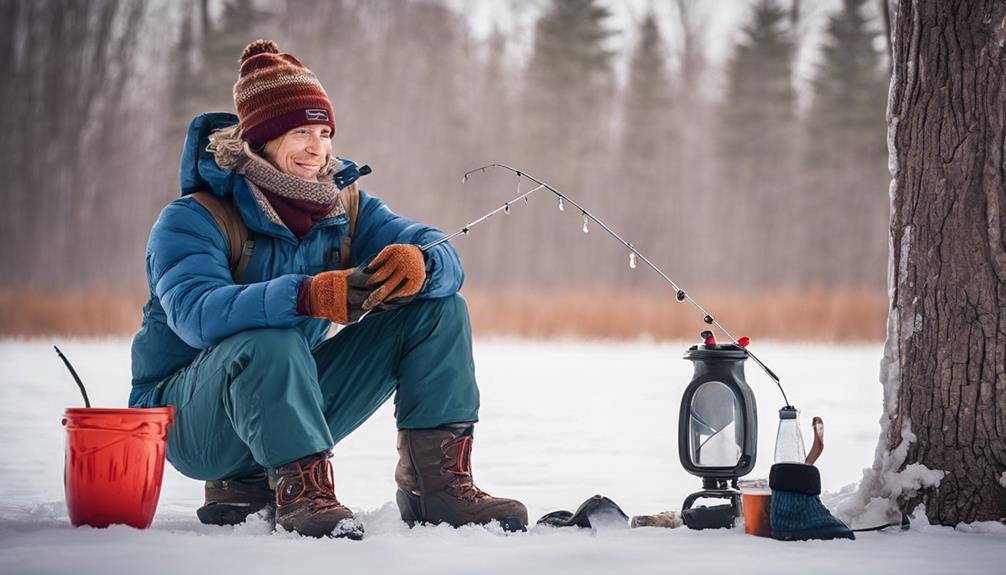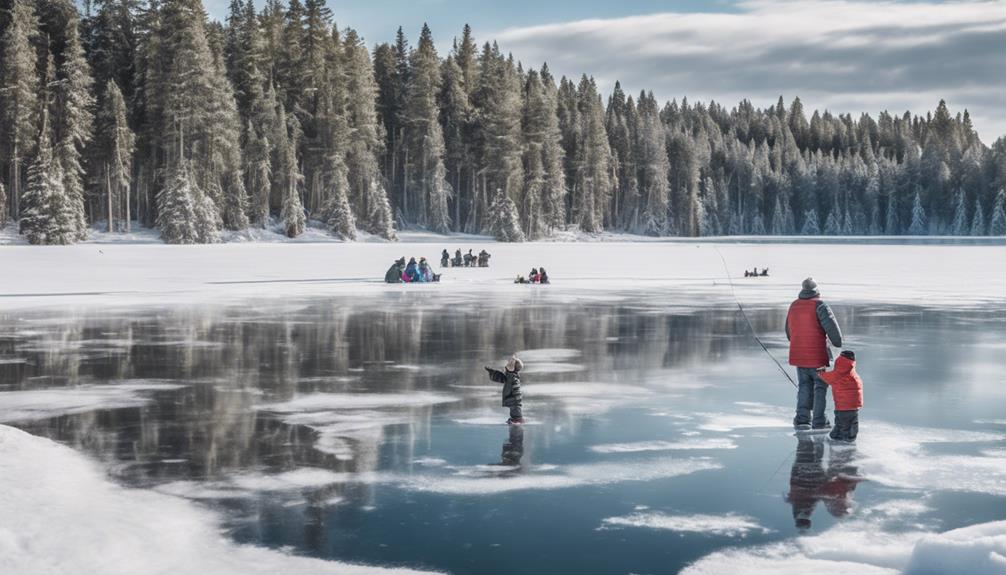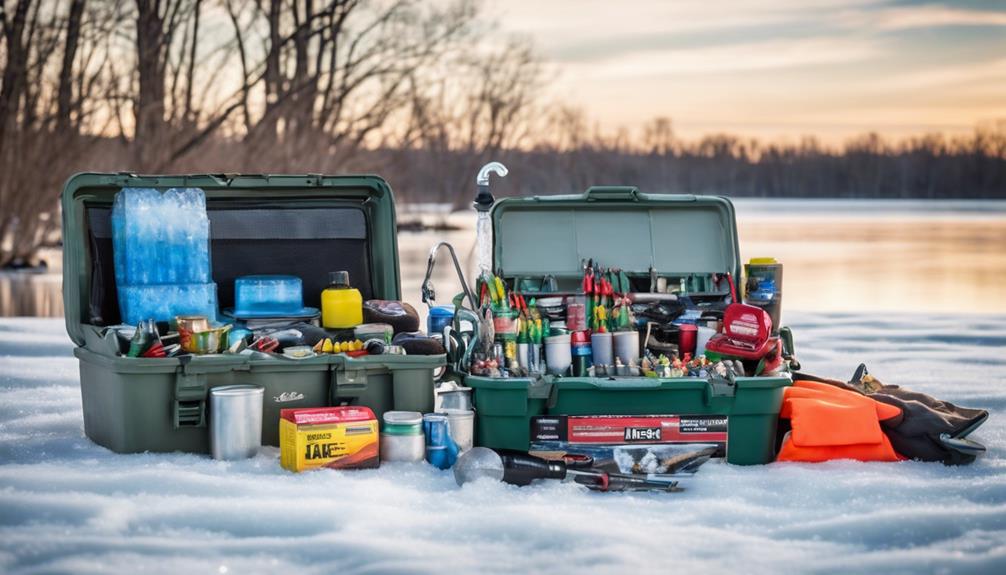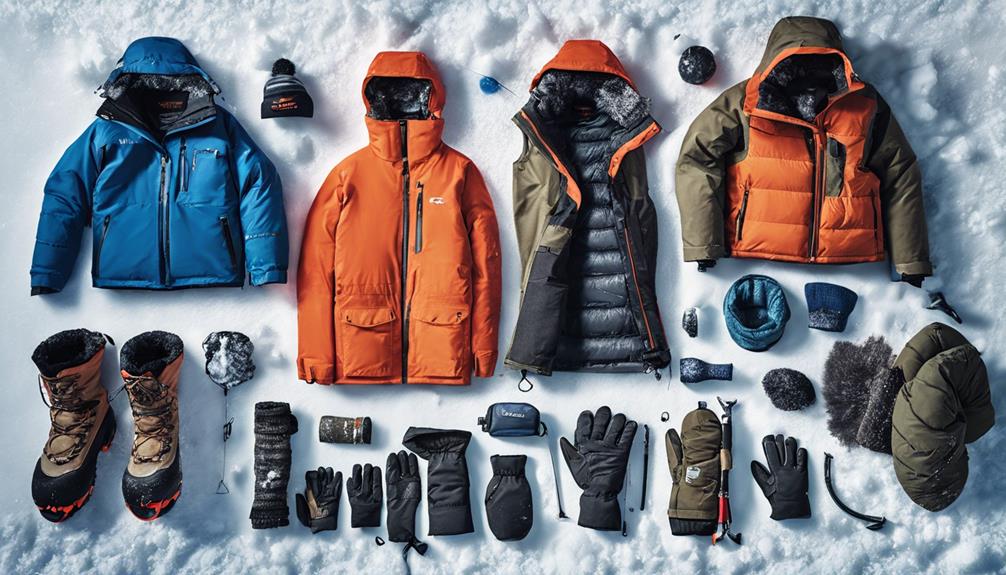When venturing onto the frozen expanse to catch some fish, it's important to remember that preparation is key. Imagine setting out without the necessary tools and knowledge only to find yourself in a precarious situation.
Understanding the significance of prepping before heading out onto the ice can make all the difference between an enjoyable experience and a potentially dangerous one.
So, why is getting ready beforehand so crucial for beginners trying their hand at ice fishing?
Safety First: Essentials for Ice Fishing
When ice fishing, always prioritize safety by equipping yourself with the essential gear to prevent accidents. One of the critical factors to consider is ice thickness. Before venturing out onto the ice, ensure that it's thick enough to support your weight. Ice thickness of at least 4 inches is generally recommended for walking, while 8-12 inches is needed for activities like ice fishing. Checking the ice thickness frequently as you move across the frozen surface is crucial to avoid accidents.
Another essential aspect of safety when ice fishing is having an emergency shelter and supplies. In case of unexpected situations such as sudden weather changes or getting stranded on the ice, having an emergency shelter can be a lifesaver. Make sure to pack a portable shelter or a tent that's easy to set up and provides protection from the cold. Additionally, carry emergency supplies like extra clothing, high-energy snacks, a first aid kit, a multi-tool, and a communication device in case you need to call for help.
Gear Up: Must-Have Equipment for Beginners
Ensure you're adequately prepared for your ice fishing adventure by gearing up with these essential items as a beginner. When heading out onto the ice, having a reliable ice shelter is crucial to shield yourself from the cold winds and provide a cozy space to fish comfortably. Ice shelters come in various styles, from pop-up tents to portable huts, offering protection from the elements while you wait for the fish to bite.
Another indispensable piece of equipment is an auger and scoop. Augers are essential for drilling holes through the thick ice, allowing you to access the water below for fishing. Hand augers are ideal for beginners, as they're lightweight and easy to use. Once you've drilled your hole, a scoop comes in handy for removing ice shavings and keeping your fishing spot clear.
Know the Ice: Understanding Ice Conditions
Understanding the ice conditions is essential for safe and successful ice fishing expeditions. As a beginner ice fisher, being aware of the ice thickness and how it can change due to temperature shifts is crucial for your safety and enjoyment.
Here are four key points to consider when assessing ice conditions:
- Ice Thickness: Always ensure the ice is thick enough to support your weight. A minimum of 4 inches of clear, solid ice is generally considered safe for ice fishing, but thicker ice may be needed for larger groups or vehicles.
- Temperature Changes: Be mindful of how temperature fluctuations can affect the quality of the ice. Rapid temperature changes can weaken the ice, making it less safe to walk or fish on.
- Visible Signs: Look out for visible signs of weak ice, such as cracks, holes, or variations in color. These could indicate areas where the ice may be thinner or weaker.
- Local Knowledge: Seek advice from experienced ice fishers or local authorities who are familiar with the ice conditions in the area. They can provide valuable insights and warnings about potential hazards.
Location Matters: Finding the Right Spot
To maximize your chances of a successful ice fishing experience, pinpointing the right location is key. When it comes to ice fishing, knowing the ice thickness is crucial for your safety. Always ensure the ice is at least 4 inches thick for walking and 8-12 inches for a small vehicle. Testing the ice thickness with an auger or ice chisel before setting up your equipment is a smart practice to prevent accidents.
Apart from ice thickness, understanding the underwater structures is essential for finding the right spot. Fish tend to gather near underwater structures like sunken trees, rocks, or drop-offs. These structures provide cover and attract baitfish, making them ideal feeding grounds for larger fish. Using a fish finder or checking local fishing reports can help you locate these underwater hotspots.
To increase your chances of a successful ice fishing trip, consider the depth of the water as well. Deeper waters often hold different species compared to shallower areas. Before drilling your hole, research the depth of the area and the species of fish you're targeting. By strategically choosing a spot with the right ice thickness and near underwater structures, you're setting yourself up for a rewarding ice fishing experience.
Bait and Lures: Choosing the Right Ones
Choosing the right bait and lures is essential for attracting fish while ice fishing. When it comes to ice fishing, the right bait and lures can make all the difference in your fishing success. Here are some tips to help you make the best choices:
- Understand the Fish: Research the type of fish you're targeting to understand their feeding habits. Different fish species are attracted to specific types of bait, so knowing your target will help you select the most effective option.
- Live Bait vs. Artificial Lures: Consider using live bait such as minnows, worms, or maggots for a more natural presentation. Artificial lures like jigs, spoons, or soft plastics can also be effective and offer a variety of colors and sizes to experiment with.
- Adapt to Conditions: Be prepared to switch up your bait and lures based on weather conditions, water clarity, and the time of day. Sometimes fish may respond better to flashy lures in murky waters, while natural bait works best in clear conditions.
- Experiment and Observe: Don't be afraid to try different bait and lure combinations. Pay attention to how the fish are responding and adjust your tactics accordingly. Ice fishing is as much about experimentation and observation as it's about technique.
Technique Tips: How to Fish on Ice
When ice fishing, mastering the right techniques is key to increasing your chances of a successful catch. Proper technique is crucial for a productive ice fishing experience. To start, drilling a hole through the ice using an auger is one of the basic ice fishing basics. Make sure the hole is large enough for your needs and clear of any ice debris. Next, using an ice scoop, remove any excess ice shavings and ensure the hole is clean for fishing.
Once your hole is ready, the way you jig your bait matters. Jigging involves moving your bait up and down in the water to attract fish. Vary your jigging technique by experimenting with different speeds and movements. Sometimes a slow, subtle jig works best, while other times a more aggressive jigging action may be needed to entice a strike.
Additionally, using a tip-up can be an effective way to fish for certain species. A tip-up is a flag-like device that signals when a fish is biting. Set the tip-up over your ice hole with your line attached, and when a fish takes the bait, the flag will pop up, alerting you to a potential catch.
Stay Warm: Dressing for Success

Make sure you dress appropriately to stay warm and comfortable while ice fishing. When out on the ice for long hours, staying warm is crucial to enjoy the experience and remain safe. Here are some essential tips to help you dress for success:
- Layering Strategy: The key to staying warm is layering your clothing. Start with a moisture-wicking base layer to keep sweat away from your skin. Add an insulating layer like fleece or wool to trap heat, and finish with a waterproof and windproof outer layer to protect you from the elements.
- Insulation Options: For extreme cold, consider investing in high-quality insulated clothing such as down jackets, insulated bibs, and thermal boots. These will help retain body heat and keep you warm throughout your ice fishing adventure.
- Heat Retention: Pay attention to areas where heat can easily escape, such as your head, hands, and feet. Wear a warm hat or beanie, insulated gloves, and thick socks to prevent heat loss from these areas.
- Moisture Management: Moisture can make you feel colder, so choose clothing made from moisture-wicking materials to keep sweat away from your body. Avoid cotton, as it retains moisture and can make you chilly.
Emergency Preparedness: Be Ready for Anything
To ensure your safety and well-being while ice fishing, being prepared for emergencies is essential. When venturing onto the ice, having a solid emergency plan can make all the difference. Start by setting up a communication plan with your fishing buddies or loved ones. Make sure someone knows your exact location and when you plan to return. In case of unexpected situations, having a reliable means of communication can be a lifesaver.
Food storage is another crucial aspect of emergency preparedness. Pack non-perishable items like energy bars, nuts, and dried fruits in case you get stranded on the ice for longer than expected. These items can provide essential nutrients and keep your energy levels up while waiting for help. Additionally, having a shelter like a portable tent or thermal blanket can protect you from harsh weather conditions if you're stuck outdoors.
First aid should never be overlooked. A basic first aid kit with essentials like bandages, antiseptic wipes, and pain relievers can help you address minor injuries on the spot. Knowing how to administer basic first aid is equally important. By preparing for emergencies in advance, you can enjoy your ice fishing experience with peace of mind, knowing you're equipped to handle whatever comes your way.
Frequently Asked Questions
How Can Beginners Ensure They Are Following All Local Regulations and Laws While Ice Fishing?
To make sure you're following all local regulations and laws while ice fishing, start by checking the requirements for permits and any conservation efforts in the area.
Keep your equipment maintained and your safety gear ready. Stay informed about any changes in the rules or restrictions.
Being proactive and respectful of the environment will help you enjoy your ice fishing experience while also protecting the local ecosystem.
Are There Any Specific Precautions That Should Be Taken When Fishing on Larger Bodies of Water Versus Smaller Ones?
When fishing on larger bodies of water, be sure to prioritize safety measures. Check ice thickness regularly, especially in deeper areas.
Maintain your equipment properly to prevent accidents. Keep an eye on weather conditions; changes can impact ice stability.
Stay informed and prepared for any situation to enjoy your ice fishing experience responsibly.
What Should Beginners Do if They Encounter Thin Ice While Out on the Lake?
If you encounter thin ice while out on the lake, it's vital to stay calm and slowly back away. Avoid sudden movements that could cause the ice to crack further.
Lie down to distribute your weight if you need to crawl back. Carry ice picks to help pull yourself out if you fall through.
Safe techniques include rolling away from the thin ice. Remember, prevention and safety measures are key for a successful ice fishing experience.
Be prepared with an emergency response plan.
How Can Beginners Identify Potential Hazards on the Ice, Such as Cracks or Weak Spots?
To identify hazards while ice fishing, beginners should always look out for cracks, changes in ice color, or areas with slush. Stay away from areas with running water underneath, like inlets or outlets. Remember to check the thickness of the ice regularly and avoid large groups or heavy machinery on the ice.
Safety precautions include carrying ice picks, a throw rope, and a life jacket. Stay alert and be prepared for anything while out on the ice.
Are There Any Ice Fishing-Specific First Aid Tips That Beginners Should Be Aware Of?
When it comes to ice fishing injuries, having first aid essentials on hand is crucial. Make sure to pack supplies like bandages, antiseptic wipes, and pain relievers in your kit.
Be prepared to treat common injuries like cuts, bruises, or even frostbite. Knowing how to properly clean and dress a wound can make a big difference in preventing infections.
Stay safe and be ready for any emergencies while out on the ice.
Conclusion
Now that you have all the essential knowledge and gear for ice fishing, you're ready to hit the ice with confidence. Remember to always prioritize safety, choose the right location, use the proper bait, and dress warmly.
By prepping thoroughly and being prepared for any situation, you can enjoy a successful and safe ice fishing experience. So grab your gear, head out to your favorite spot, and enjoy the thrill of ice fishing!



